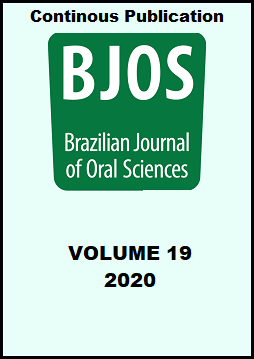Abstract
Composites have been proven to have a cytotoxiceffect on a variety of tissues and cells. Aim: The aim of thisstudy was to analyse the degree of conversion of resinsand its correlation with the cell viability in primary gingivalfibroblasts. Methods: Resin-based silorane (Filtek P90)and conventional methacrylate resins (Filtek Z100, FiltekZ250 and Filtek Z350XT) were used to evaluate cell viabilityand the degree of conversion. The resins were light-cured bya LED for 20 and 40 seconds. The degree of conversion wasanalysed by Fourier transform infrared spectroscopy. Cellularmetabolism was evaluated after 24 hours by the MTT assay(n = 6) using the storage solution of composite resin foreither 24 hours or 12 days. Variance analysis (ANOVA) witha Bonferroni correction (p < 0.05) was performed to comparethe groups. Results: The composite Filtek P90 showed ahigher degree of conversion when polymerised for 40 or20 seconds, while the composites Filtek Z100, Filtek Z250 andFiltek Z350XT showed similar degree of conversion. Only theFiltek Z100 resin was cytotoxic. Conclusion: We found nostatistically significant correlation between cell viability andthe degree of conversion.
References
Vieira AR, Silva MB, Souza KKA, Filho AVA, Rosenblatt A, Modesto A. A Pragmatic Study Shows Failure of Dental Composite Fillings Is Genetically Determined: A Contribution to the Discussion on Dental Amalgams. Front Med (Lausanne). 2017 Nov 6;4:186. doi: 10.3389/fmed.2017.00186.
Santerre JP, Shajii L, Leung BW. Relation of dental composite formulations to their degradation and the release of hydrolyzed polymeric-resin-derived products. Crit Rev Oral Biol Med. 2001;12(2):136-51. doi: 10.1177/10454411010120020401.
Al-Boni R, Raja OM. Microleakage evaluation of silorane based composite versus methacrylate based composite. J Conserv Dent. 2010 Jul;13(3):152-5. doi: 10.4103/0972-0707.71649..
Jerg A, Schulz SD, Tomakidi P, Hellwig E, Polydorou O. Modulation of gingival cell response towards dental composites. Dent Mater. 2018 Mar;34(3):412-26. doi: 10.1016/j.dental.2017.11.025.
Franz A, König F, Lucas T, Watts DC, Schedle A. Cytotoxic effects of dental bonding substances as a function of degree of conversion. Dent Mater. 2009 Feb;25(2):232-9. doi: 10.1016/j.dental.2008.07.003.
Eick JD, Barragan-Adjemian C, Rosser J, Melander JR, Dusevich V, Weiler RA, Met al. Silorane resin supports proliferation, differentiation, and mineralization of MLO-A5 bone cells in vitro and bone formation in vivo. J Biomed Mater Res B Appl Biomater. 2012 Apr;100(3):850-61. doi: 10.1002/jbm.b.32649.
Duarte S Jr, Botta AC, Phark JH, Sadan A. Selected mechanical and physical properties and clinical application of a new low-shrinkage composite restoration. Quintessence Int. 2009 Sep;40(8):631-8.
Yesilyurt C, Yoldas O, Altintas SH, Kusgoz A. Effects of food-simulating liquids on the mechanical properties of a silorane-based dental composite. Dent Mater J. 2009 May;28(3):362-7. doi: 10.4012/dmj.28.362.
Mousavinasab SM, Atai M, Salehi N, Salehi A. Effect of Shade and Light Curing Mode on the Degree of Conversion of Silorane-Based and Methacrylate-Based Resin Composites. J Dent Biomater. 2016 Dec;3(4):299-305.
Longo DL, Paula-Silva FW, Faccioli LH, Gatón-Hernández PM, Queiroz AM, Silva LA. Cytotoxicity and cytokine expression induced by silorane and methacrylate-based composite resins. J Appl Oral Sci. 2016 Jul-Aug;24(4):338-43. doi: 10.1590/1678-775720150449.
Małkiewicz K, Wychowański P, Olkowska-Truchanowicz J, Tykarska M, Czerwiński M, Wilczko M, et al. Uncompleted polymerization and cytotoxicity of dental restorative materials as potential health risk factors. Ann Agric Environ Med. 2017 Dec 23;24(4):618-23. doi: 10.5604/12321966.1235159.
Johnsen GF, Thieu MK, Hussain B, Pamuła E, Reseland JE, Lyngstadaas SP, et al. Own brand label restorative materials-A false bargain? J Dent. 2017 Jan;56:84-98. doi: 10.1016/j.jdent.2016.11.004.
Gonçalves F, Campos LMP, Rodrigues-Júnior EC, Costa FV, Marques PA, Francci CE, et al. A comparative study of bulk-fill composites: degree of conversion, post-gel shrinkage and cytotoxicity. Braz Oral Res. 2018 Mar 8;32:e17. doi: 10.1590/1807-3107bor-2018.vol32.0017.
Gontijo SML, Gomes ADM, Gala-García A, Sinisterra RD, Esperanza Cortés M. Evaluation of antimicrobial activity and cell viability of aloe vera sponges. Electron J Biotechnol. 2013;16(1):1-10. doi: 10.2225/vol16-issue1-fulltext-2.
Volk J, Engelmann J, Leyhausen G, Geurtsen W. Effects of three resin monomers on the cellular glutathione concentration of cultured human gingival fibroblasts. Dent Mater. 2006 Jun;22(6):499-505. doi: 10.1016/j.dental.2005.06.002.
Kong N, Jiang T, Zhou Z, Fu J. Cytotoxicity of polymerized resin cements on human dental pulp cells in vitro. Dent Mater. 2009 Nov;25(11):1371-5. doi: 10.1016/j.dental.2009.06.008.
Magne P, Malta DA, Enciso R, Monteiro-Junior S. Heat Treatment Influences Monomer Conversion and Bond Strength of Indirect Composite Resin Restorations. J Adhes Dent. 2015 Dec;17(6):559-66. doi: 10.3290/j.jad.a35258.
Ferracane JL, Condon JR. Rate of elution of leachable components from composite. Dent Mater. 1990 Oct;6(4):282-7. doi: 10.1016/S0109-5641(05)80012-0.
Palin WM, Fleming GJ, Nathwani H, Burke FJ, Randall RC. In vitro cuspal deflection and microleakage of maxillary premolars restored with novel low-shrink dental composites. Dent Mater. 2005 Apr;21(4):324-35. doi: 10.1016/j.dental.2004.05.005.
R Ruyter IE, Oysaed H. Composites for use in posterior teeth: composition and conversion. J Biomed Mater Res. 1987 Jan;21(1):11-23. doi: 10.1002/jbm.820210107.
Monte Alto RV, Guimarães JG, Poskus LT, da Silva EM. Depth of cure of dental composites submitted to different light-curing modes. J Appl Oral Sci. 2006 Apr;14(2):71-6. doi: 10.1590/s1678-77572006000200002.
Balbinot EDCA, Pereira MFCC, Skupien JA, Balbinot CEA, da Rocha G, Vieira S. Analysis of transmittance and degree of conversion of composite resins. Microsc Res Tech. 2019 Nov;82(11):1953-61. doi: 10.1002/jemt.23364.
Lin GSS, Abdul Ghani NRN, Ismail NH, Singbal KP, Yusuff NMM. Polymerization Shrinkage and Degree of Conversion of New Zirconia-Reinforced Rice Husk Nanohybrid Composite. Eur J Dent. 2020 Jul;14(3):448-55. doi: 10.1055/s-0040-1713951.
Calheiros FC, Braga RR, Kawano Y, Ballester RY. Relationship between contraction stress and degree of conversion in restorative composites. Dent Mater. 2004 Dec;20(10):939-46. doi: 10.1016/j.dental.2004.03.003.

This work is licensed under a Creative Commons Attribution 4.0 International License.
Copyright (c) 2020 Brazilian Journal of Oral Sciences


